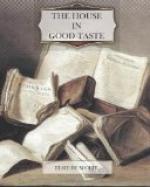One of the best halls in America is that of “Westover,” probably the most famous house in Virginia. This old house was built in 1737 by Colonel Byrd on the James River, where so many of the Colonial aristocrats of Virginia made their homes. The plan of the hall is suggestive of an old English manor house. The walls are beautifully paneled from an old English plan. The turned balusters are representative of the late Seventeenth or early Eighteenth Century. The fine old Jacobean chairs and tables have weathered two centuries, and are friendly to their new neighbors, Oriental rugs older than themselves. The staircase has two landings, on the first of which stands an old Grandfather’s-clock, marking the beginning of a custom that obtains to this day.
This hall is characteristic of American houses of the Colonial period, and indeed of the average large country house of to-day, for the straightaway hall, cutting the house squarely in two, is so much a part of our architecture that we use it as a standard. It is to be found, somewhat narrower and lower of ceiling, in New England farmhouses and in Eastern city houses. The Southern house of ante-bellum days varied the stair occasionally by patterning the magnificent winding staircases of old England, but the long hall open at both ends, and the long stair, with one or two landings, is characteristic of all old American houses.
The customary finish for these old halls was a landscape wall paper, a painted wall broken into panels by molding, a high white wainscoting with white plaster above, or possibly a gay figured paper of questionable beauty. Mahogany furniture was characteristic of all these halls—a grandfather’s-clock, a turn-top table, a number of dignified chairs, and a quaint old mirror. Sometimes there was a fireplace, but oftener there were doors opening evenly into various rooms of the first floor. These things are irreproachable to-day. Why did we have to go through the period of the walnut hat-rack and shiny oak hall furniture, only to return to our simplicities?
[Illustration: THE STAIRCASE IN THE BAYARD THAYER HOUSE]
When I planned the main hall of the Colony Club I determined to make it very Colonial, very American, very inviting and comfortable, the sort of hall you like to remember having seen in an old Virginia house. One enters from the street into a narrow hall that soon broadens into a spacious and lofty living-hall. The walls are, of course, white, the paneled spaces being broken by quaint old Colonial mirrors and appropriate lighting-fixtures. There is a great fireplace at one end of the hall, with a deep, chintz-covered davenport before it. There are also roomy chairs covered with the same delightful chintz, a green and white glazed English chintz that is as serviceable as it is beautiful. Besides the chintz-covered chairs, there are two old English chairs covered with English needlework. These chairs are among the treasures of the Club. There are several long mahogany tables, and many small tea tables. The rugs are of a spring green—I can think of no better name for it.




